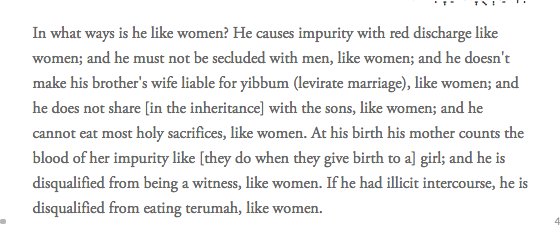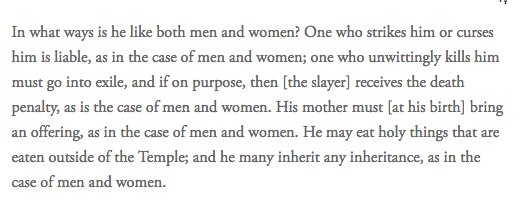True fact.
Also, interestingly, this fact enabled probably the first major trans-friendly modern Jewish legal ruling. Kind of a story, so: thread. https://twitter.com/amydentata/status/935322429949227008
Also, interestingly, this fact enabled probably the first major trans-friendly modern Jewish legal ruling. Kind of a story, so: thread. https://twitter.com/amydentata/status/935322429949227008
So. 2 Kings 2:11– Elijah the prophet is sucked up to Heaven in a whirlwind. This lead some medieval scholars to ask after the status of his marriage. He hadn’t died. But he also hadn’t granted his wife a divorce. Could she remarry?
Eventually (after some debate) they concluded that she wasn’t married to a man anymore, but an angel. And female-angel marriage wasn’t a thing that has a status in Jewish law, so the marriage was annulled. She could remarry. (Sup 280)
(Sorry this is slow, lots happening out here in external reality.)
In 1998, Dana International, an Israeli trans woman, won the Eurovision Song Contest. Around that time, Israeli religious leaders fell into a tizzy, What Is Trans subcategory.
In 1998, Dana International, an Israeli trans woman, won the Eurovision Song Contest. Around that time, Israeli religious leaders fell into a tizzy, What Is Trans subcategory.
If Dana International was assigned male at birth, did she count in a minyan (quorum for prayer, only men in Orthodox sectors)? To what mitzvot was she obligated? Exempt? Is SRS permitted according to Jewish law? And so on.
Mostly the guys issuing legal rulings said some variation on the transphobic things you would expect from Orthodox and ultra-Orthodox Israeli rabbis in the late 90’s. But while citing Talmud.
Then there was Rabbi Eliezer Waldenberg, aka the Tzitz Eliezer, who sat on the Supreme Rabbinical Court & was a major decisor of Jewish law.
He looked to the medieval ruling upthread and concluded that a change in gender status leads to a change in legal status. Elijah transitioned from man to angel, a being with a different gender. So wife didn’t need the divorce.
Therefore, trans folks who transition are the gender they transition into. Therefore Dana International was a woman legally (and, ok, didn’t count in a minyan, don’t get me off on the egalitarian tear now.) We believe what she tells about her gender.
Granted, he went by “external anatomy,” aka he argued one needed to have gender confirmation surgery to change legal status—but still. Not bad for an ultra-Orthodox guy born in 1915, under the Ottoman Empire.
Obviously I don’t think you need surgery for me to believe you about your gender.
OK, I've been meaning for ages to do a very miscellaneous thread about non-cis gender stuff in Judaism, so I suppose I'll continue here. This will be extremely non-comprehensive, and I'm sure I'll forget important stuff, please remind/prompt me if you know things.
The first place we'll look is the Mishnah. We Jews call Mishnah the Oral Torah. it's mostly (not all) a collection of laws that form the basis of Rabbinic Judaism--eg the Torah says "keep the Sabbath." The Mishnah lists the 39 categories of work forbidden on Shabbat. For example.
Depending on your theology, the Mishnah was either given by God at Sinai to Moses and passed along orally or developed organically over centuries. Either way, it wasn't written down until ca. 150 CE, when Judaism was at a crisis point (post-Temple, Bar Kochba, etc).
According to the Mishnah, there are 6-7 gender/sex categories.
1) Male
2) female.
3) Androginos has both “male” and “female” sexual characteristics.
4) Tumtum's sexual characteristics are indeterminate or obscured.
1) Male
2) female.
3) Androginos has both “male” and “female” sexual characteristics.
4) Tumtum's sexual characteristics are indeterminate or obscured.
5) Ilonit is assigned female at birth, develops male sex characteristics at puberty
6) Saris hamah is assigned male at birth, develops female sex characteristics "naturally."
7) Saris adam is assigned male at birth, develops female sex characteristics through human intervention
6) Saris hamah is assigned male at birth, develops female sex characteristics "naturally."
7) Saris adam is assigned male at birth, develops female sex characteristics through human intervention
Note that mostly (besides the cis ones) these are intersex folks, tho I suppose there's a more interesting conversation re: how saris adam as a category maps onto or doesn't map onto how we think of trans now. I assume folks have worked on this, don't have citations in my pocket.
Now, what's interesting is how androginos and timtum get treated by the Rabbis. Usually they're very binary about things--things are kosher or not, something is forbidden or permitted. But here, there's a lot more nuance and complexity.
Their legal status (viz to what commandments they are obligated, eg) is this limnal legal space between male and female. This is Mishnah Bikkurim 4:1-2. (The rest of the chapter goes on in this vein.)
(Sorry about their translation of androginos; it was the best I found.)
(Sorry about their translation of androginos; it was the best I found.)
(And I barely have time to tweet you people this, don't have time to go in and retranslate things, OK?)
A wonderful thing here--as the great Rabbi Elliot Kukla observed (in a beautiful essay in my antho Passionate Torah)--is that the Rabbis have to figure out *who* the androginos and timtum will marry. Because of course they will have love and partnership!
Of course they're part of our community and loved and serving God! It's kind of a far cry from how trans and intersex folks have been/are treated in some parts of contemporary culture.
You should read a lot of Rabbi Kukla. He and Rabbi Reuben Zellman put together http://www.transtorah.org ages ago. Lots of great stuff there. Like this: http://transtorah.org/PDFs/How_I_Met_the_Tumtum.pdf
OK, as long as this is happening in a stream of consciousness way, here are some other resources. This book: https://www.amazon.com/Balancing-Mechitza-Transgender-Jewish-Community/dp/1556438133/ref=sr_1_1?s=books&ie=UTF8&qid=1511918923&sr=1-1&keywords=mechitza+trans+balancing
Tons of great stuff at https://www.keshetonline.org/ (aka @KeshetGLBTJews). Read @JoyLadin's stuff. The amazing @sbearbergman. This is his most recent and it's so stunningly lovely. Buy it right now. https://www.amazon.com/Blood-Marriage-Wine-Glitter-Bergman/dp/1551525119/ref=sr_1_1?s=books&ie=UTF8&qid=1511919030&sr=1-1&keywords=blood+marriage+bear+bergman
Micah Bazant made this zine in 2000 or 2001 and it's a powerful work of art: http://www.qzap.org/v5/gallery/main.php?g2_view=core.DownloadItem&g2_itemId=1552
I have more stuff to say (and more work to signal boost) but need to take a break from this now and be with the 3-dimensional people. Will circle back later.
Nice postscript on the Tzitz Eliezer, including how his thinking on trans issues played out in various issues of Jewish law, from @SojournGSD, by @rjmedwed: http://www.sojourngsd.org/blog/tzitz
Ahh @abbychavastein has put together a great source sheet with tons of great traditional texts that nuance or complicate gender concepts:
https://www.sefaria.org/sheets/72710
https://www.sefaria.org/sheets/72710
I was reminded of the midrash (uh, Rabbinic legend) about the creation of humans and how it fits in here. So. Starts with Genesis 1:27: "And God created man in God's image, in the image of God God created it; male and female God created them."
Then all this other stuff happens and then suddenly we're at Genesis 2:20-23, eg this part "And the LORD God fashioned the rib that God had taken from the man into a woman; and God brought her to the man." and etc.
So the Rabbis are confused. Didn't man and woman get created co-equally like, a whole chapter ago? Biblical critical methods'd say these were two authorship strands, but the Rabbis roll in the land of midrash--they play with the expansive possibilities this incongruity offers.
One answer is that Adam had a first wife, Lilith, created co-equally in Gen 1, and that didn't work out so God made a second wife, Eve. This is a digression but it's an amazing midrash: https://jwa.org/media/alphabet-of-ben-sira-78-lilith
Another is that the first human was actually intersex, and Genesis 1 talks about creating that person, and Genesis 2 talks about splitting that person into 2 genders, playing with the fact that tzela, rib, also gets used to mean "side" in eg Ex 26:20 https://www.sefaria.org/Bereishit_Rabbah.8.1?lang=bi
So it would read "So the LORD God cast a deep sleep upon the human; and, while they slept, God took one of their sides and closed up the flesh at that spot." Thus splitting the person into two sides, two different people with different genders.
So in this midrash, the first human being--created in God's image, mind you--is intersex.
Back to the Lilith midrash bc it deserves a tweet: you caught that she refused to be on the bottom during sex bc “The two of us are equal, since we are both from the earth.”? Then "Since Lilith saw [how it was], she uttered God's ineffable name and flew away into the air."
She saw how it was.
And then she turned into a demon who gives babies SIDS. It's quite a midrash.
And then she turned into a demon who gives babies SIDS. It's quite a midrash.
OK, since this thread is already impossibly long and winding and contains all sorts of things, I'll just indulge myself here. Ever since I wrote it I've been annoyed at myself that I didn't share more on Mishnah Bikkurim (Ch 4).
I didn't bc I still feel that to do this justice I need to go in and retranslate, which I'm not gonna do, so fine, here. The whole series of mishnayot better shows you how the Rabbis are thinking of this. Sorry for less optimal translation here, I'd try to do more respectfully.
Context is that lots of aspects of Jewish law in the Rabbinic world are gendered. So again, an androginos, an intersex person, is sometimes obligated to Jewish law as men are, sometimes as women are, sometimes as both, sometimes as neither. So, male legal obligations:
Ways in which the androginos' legal status is unique viz cisgender folks. And note the end, Rabbi Yose says: the androginos is a unique creature, and the sages could not decide about him.
They also mention that the timtum is a person whose gender status and identity appears to be shape-shifty. "But this is not so with a tumtum (one of doubtful sex), for sometimes they are a man and sometimes they are a woman."
The bottom line is this: Intersex folks in the Mishnah and etc. are not outcasts, not scary or threatening--but they are a challenge for Rabbis who think in very binary ways (male/female, kosher/not-kosher, Shabbat/mundane time etc).
But obviously these Jews are also Jews, and so the challenge is to figure out not whether, but how they will fit into this binary framework. Because of course they will perform mitzvot and marry and be part of the justice system and etc.
Rabbi Reuben Zellman has a beautiful piece comparing folks who don't fall into clean binary gender categories to twilight--also a complicated time for the Rabbis, neither fully day nor fully night. In-between times.
http://transtorah.org/PDFs/Holiness_of_Twilight.pdf
http://transtorah.org/PDFs/Holiness_of_Twilight.pdf
Should we add some prayers and rituals around gender transition? There's this one (name of book where it came from in-thread): https://twitter.com/remembrancermx/status/1020484873520156673
There's this one, from the good Rabbi Elliot Kukla: http://transtorah.org/PDFs/Blessing_for_Transitioning_Genders.pdf
There's a whole big pile of different rituals and prayers over at @Ritualwell: https://www.ritualwell.org/gender-transitioning
There are lots of things out there. I should probably dig up the ritual for gender transition I wrote in rabbinical school (riffing off the ritual for conversion, which also effects an ontological change) & publish it somewhere, huh? But I feel like so many people have got this.
Anywhichway, I think the mikveh, the ritual bath, is a pretty great place to ritualize transition. https://forward.com/articles/181849/marking-gender-transition-in-the-mikveh/
Here's another mikveh/ritual bath one, from the great folks at @MayyimHayyim: https://www.mayyimhayyim.org/wp-content/uploads/2017/11/Ceremony-GenderTransition.pdf
Here's a thread on non-binary gender and the very gendered language of Modern Hebrew: https://twitter.com/TheRaDR/status/1024564197575806978

 Read on Twitter
Read on Twitter








